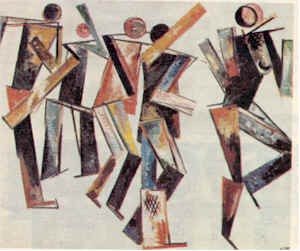Varvara Stepanova Варвара Фёдоровна Степанова (1894-1958)
Get a Stepanova Certificate of Authenticity for your painting (COA) for your Stepanova drawing.
For all your Stepanova artworks you need a Certificate of Authenticity (COA) in order to sell, to insure or to donate for a tax deduction.
Getting a Stepanova Certificate of Authenticity (COA) is easy. Just send us photos and dimensions and tell us what you know about the origin or history of your Stepanova painting or drawing.
If you want to sell your Stepanova painting or drawing use our selling services. We offer Stepanova selling help, selling advice, private treaty sales and full brokerage.
We have been authenticating Stepanova and issuing certificates of authenticity since 2002. We are recognized Stepanova experts and Stepanova certified appraisers. We issue COAs and appraisals for all Stepanova artworks.
Our Stepanova paintings and drawings authentications are accepted and respected worldwide.
Each COA is backed by in-depth research and analysis authentication reports.
The Stepanova certificates of authenticity we issue are based on solid, reliable and fully referenced art investigations, authentication research, analytical work and forensic studies.
We are available to examine your Stepanova painting or drawing anywhere in the world.
You will generally receive your certificates of authenticity and authentication report within two weeks. Some complicated cases with difficult to research Stepanova paintings or drawings take longer.
Our clients include Stepanova collectors, investors, tax authorities, insurance adjusters, appraisers, valuers, auctioneers, Federal agencies and many law firms.
We perform Varvara Stepanova art authentication, appraisal, certificates of authenticity (COA), analysis, research, scientific tests, full art authentications. We will help you sell your Varvara Stepanova or we will sell it for you.

Varvara Stepanova was a Russian artist assocated with the ‘Constructivist’ movement. She came from peasant origins but was fortunate enough to get an education at Kazan School of Art, Odessa. There she met her life-long friend and collaborator Alexander Rodchenko. In the years before the Russian Revolution of 1917 they shared an apartment in Moscow with Wassily Kandinsky and through him met Aleksandra Ekster and Liubov Popova. These artists became some of the main figures in the Russian avant-garde. The new abstract art in Russia which began around 1909, was a culmination of influences from Cubism, Italian Futurismand traditional peasant art. She designed Cubo-Futurist work for several artists’ books.

In the years following the revolution, Stepanova contributed work to the Fifth State Exhibition and the Tenth State Exhibition, both in 1919. In 1920 came a division between painters like Kasimir Malevich who continued to paint with the idea that art was a spiritual activity, and those who believed that they must work directly for the revolutionary development of the society. Stepanova declared in her text for the exhibition 5×5=25, held in Moscow in 1921: ‘Composition is the contemplative approach of the artist. Technique and Industry have confronted art with the problem of construction as an active process and not reflective. The ‘sanctity’ of a work as a single entity is destroyed. The museum which was the treasury of art is now transformed into an archive’.

The term ‘Constructivist’ was by then being used by the artists themselves to describe the direction their work was taking. The theatre was another area where artists were able to communicate new artistic and social ideas. Stepanova designed the sets for The Death of Tarelkin in 1922. She carried out her ideal of engaging with industrial production in the following year when she, with Popova, became designer of textiles at the Tsindel (the First State Textile Factory) near Moscow, and in 1924 became professor of textile design at the Vkhutemas (Higher Technical Artistic Studios) while continuing typography, book design and contributing to the magazine LEF. Still wondering about a Russian painting in your family collection? Contact us…it could be by Varvara Stepanova.
Reviews
1,217 global ratings
5 Star
4 Star
3 Star
2 Star
1 Star
Your evaluation is very important to us. Thank you.
